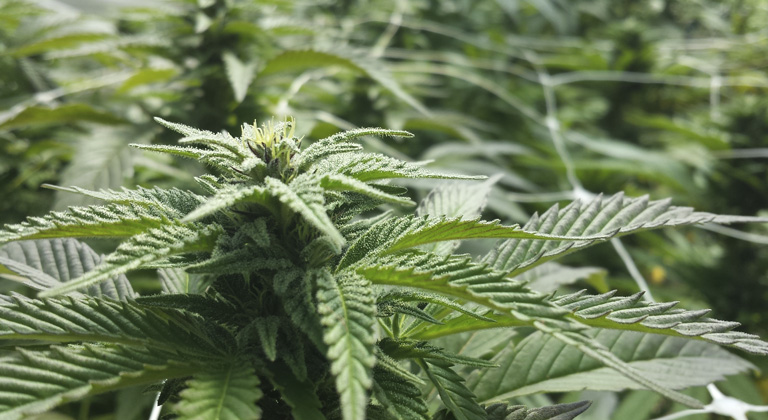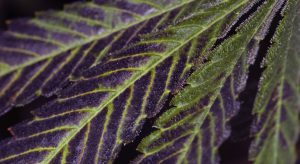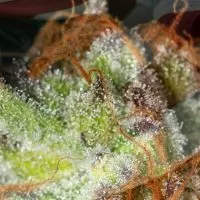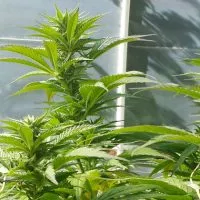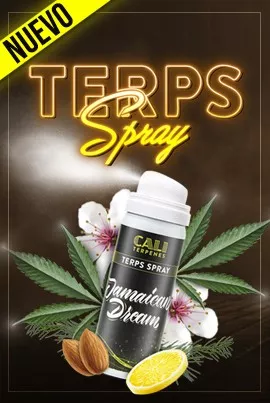What are Gardening Tools?
If you’re planning on getting started in outdoor growing, keep in mind that although it may be cheaper than setting up an indoor grow, you’ll have to deal with all of the problems that come along with an unpredictable climate.
In order to do this, you’ll need to choose your growing material depending on your needs, choosing the right gardening tools that will help you to have a successful outdoor growing experience.
Propagators and Flowerpots
The first thing that your plants are going to need is a home where they can root and hold on to their substrate. The size of the flowerpot is super important, especial for photoperiodic plants.
You’ll need to start out with small flowerpots and increase them in size via transplanting until the flowering period starts; this stimulates root growth and increases the overall size of your plant. In order to do this, you can use:
Propagators
When it comes to outdoor growing, small propagators and greenhouses can be incredibly useful for the first few weeks of growth until you can transplant to a larger flowerpot. You can use them with 0.2 – 0.4 L flowerpots, transplanting the second that the roots start showing through the bottom.
Greenhouses can help maintain humidity and they also protect delicate saplings and seedlings from insects and birds, which can devastate them in just one sitting.
Flowerpots
Outdoors, we highly recommend using white flowerpots, as they reflect the sun and keep the roots from heating up too much. The flowerpots you use will depend on the type of plant you plan on growing:
- When it comes to autoflowering plants, we recommend planting germinated seeds straight into their definitive flowerpot (Max 25L), because they won’t have enough time to recover from the stress of transplanting.
- When it comes to feminized or regular seeds, you can increase the size of their flowerpot, starting with 5 – 11 L, making sure to stop transplanting before they start flowering.
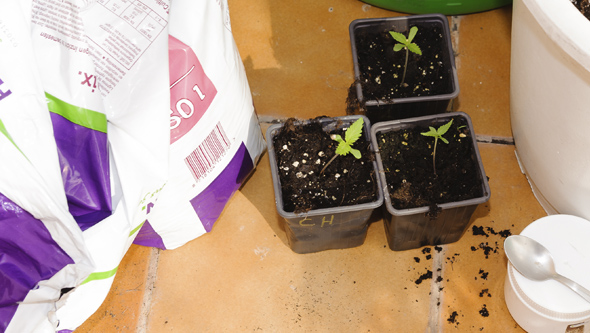
A great option for your final flowerpot is the Smart Pot, a geo-textile flowerpot with permeable and flexible fabric made out of synthetic fibre; plants will be able to grow their roots as if they were in soil thanks to these factors. Plus, you can clean them and store them folded up so that they take up less space than a plastic flowerpot.
You can check out our complete post if you’re looking for information about when and how to transplant cannabis plants.
Trays
You’ll also need to have either round or square trays, depending on the flowerpot, for putting underneath your pots in order to avoid water spilling out onto the floor; this is especially important if you’re growing on a balcony; if the water runs down it may annoy your neighbours.
Watering Tools
As well as a home, your plants need water in order to survive, and this water is also a source of nutrition for your plants if you follow a growing schedule with liquid and soluble products. Watering tools are super important when it comes to feeding your plants.
Watering cans, wands and tanks
The most simple watering tools are cans and watering wands. If you have a small grow, you should have enough with a couple of watering cans (one for mixing nutrients and letting it mix, and the other for transferring the mixture and oxygenating the solution before watering).
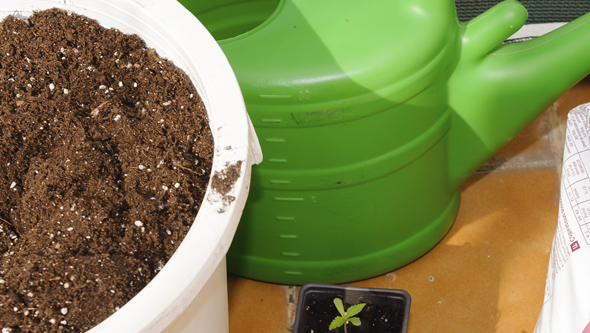
If you have a larger or tighter grow, watering cans may not be enough, as you’ll have to mix your nutrients in again and again. In this case, you can use a watering wand with a tank in order to each all of your plants easily.
A useful set up in this case would be a 70 L flowerpot, a small electric motor and a watering wand. At La Huerta Grow Shop you can find all of these tools in one simple watering kit, allowing you to water plenty of plants and easily reach the entire growing area.
Sprayers, pipettes and measuring jars
There are other gardening tools that are just as important as a good watering can, and they are those which help you to add nutrients and preventive products to your water and plants.
Sprayers can be used to apply nutrients straight to the leaves, as well as preventive products for fungi and insect infesations; we recommend using new sprayers rather than re-used sprayers, as the residues from the sprayer may cause issues if they aren’t cleaned out properly.
Some advice that’s useful for keeping your sprayer clean; if you use insecticides or fungicides, fill the sprayer with water when you’re finished and spray it in order to clean out the nozzle and micro-sprayer.
Plastic pipettes and measuring jars are super useful for measuring the exact amount of nutrients and additives that you want to add to your water. They’re super useful and much safer when it comes to using acidic products such as pH adjusters.
Pipettes allow you to add products in small drops, making them ideal for fertilizers and additives that are highly concentrated. At La Huerta Grow Shop you can find different sized pipettes and measuring jars and cups.
pH and EC Meters
Another important factor to keep in mind is the quality of your water and nutrient solution; incorrect pH (acidity) and EC (electroconductivity) levels can ruin your plants entirely. In order to manage these parameters, there are various types of meters.
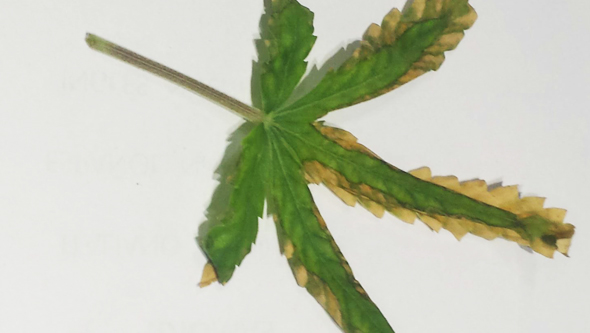
pH Meter
pH meters are designed to measure the acidity in your water and nutrient solution. If your plants aren’t getting the right pH levels, they won’t be able to absorb certain nutrients and they’ll begin showing symptoms of deficiencies and nutrient blockage; every nutrient needs a specific pH range to be absorbed.
The ideal pH level is around 5.3 to 6.5, depending on the substrate and the fertilizers used. For most substrates and nutrients in soil, pH should be at around 6.5. Most nutrient and feeding schedules come with the correct pH level indicated on the container.
pH can be measured using a pH meter and, if necessary, liquids used to adjust pH such as pH+ or pH-. The objective here is to use water and nutrient solutions with the right pH levels in order to guarantee a successful growth and flowering period. There are various types of pH meter:
- Reactive kits: these kits are easy to use; simple mix some drops of the reactive liquid with some of your water and compare the results with the colour chart that comes with the kit.
- Digital pH meter: these meters are much more exact than the previous, although they’ll need to be calibrated periodically. You can do this by submerging their sensor in a calibration solution and adjusting the buttons or screws accordingly, depending on the model. Some pH meters use a pH7 calibration solution and other use both pH7 and pH4. You’ll also need to store them with the some maintenance liquid in the lid.
If you want to simplify your grow even more, there are some nutrients that automatically adjust the pH to the correct level. These nutrients are called pH Perfect. For example, Micro Bloom and Grow ranges, Sensi Grow and Sensi Bloom, and the Connoisseur Grow and Bloom products by Advance Nutrients have this technology.
EC Meter
Ec Meters are used to figure out the amount of dissolved mineral salts in your water. The most common unit of measurement used is mS. EC meters can also be used to calculate the exact amount of nutrients that your plants need in each phase. In order to calibrate your EC meter you’ll need an EC calibration solution.
Keeping an eye on the EC in your water is super important in order to determine general water quality. According to quality, water can be classified as:
- Soft water: from 0 to 0.4 mS
- Normal water: from 0.4 to 0.8 mS
- Hard water: from 0.8 to 1.2 mS
- Water is considered unusable for cannabis over 1.2 mS
EC and pH meters tend to also include a digital thermometer that measures the water temperature; this is useful for watering at a steady 20 – 23°C, the ideal temperature for highly oxygenated water.
If you test your tap water and it comes out hard or unusable, you can use an osmosis filter in order to turn it into high quality water. Osmosis waters are really useful for growers that live in areas or regions with bad water quality.
Water obtained from the reverse osmosis process must be improved using calcium and magnesium until it reaches around 0.4 – 0.5 mS. In order to do this, you’ll need to add 2/3 parts calcium and 1/3 parts magnesium. There are additives designed for this exact purpose with the right proportions of both elements.
Other Tools
Apart from the necessary tools needed for every day chores when it comes to your plants, there’s quite a long list of accessories and tools that can help to make the outdoor growing process much easier, more efficient and more productive. For example, tags are super helpful if you plan on growing different strains or various different types of clones at once. Some of the most helpful tools for growing cannabis outdoors are:
Microscopes
Microscopes are useful for many reasons; they allow you to observe your plants up close in order to detect signs of insects, fungi or other illnesses. They’re also ideal for identifying the right moment to harvest by observing the colour and shape of your plants’ trichomes.
Trichomes are resin glands that grow mainly on buds and cannabis leaves during the flowering period. This is where most cannabinoids and terpenes are concentrated, which are in charge of flavour, aroma and effect.
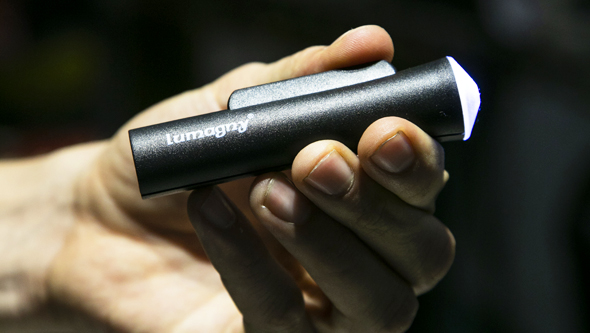
The colour of your trichomes is the best way to tell if your cannabis plants are ready to harvest; when they go opaque and milky and some turn an amber colour is when you’ll want to harvest. This allows for more potent and aromatic flowers.
If you harvest too early, the obtained cannabis will have a much smoother effect, and less aroma and flavor, with a more mental effect. On the other hand, if you harvest too late the effect will still be smoother, but more relaxing. It’s important to harvest at just the right time in order to obtain the maximum potential from your plants flavour, aroma and effects.
Scissors, stakes and pruning tools
Scissors are some of the most important tools when it comes to various different jobs regarding your plants; they can be used to prune carefully, to take cuttings from mother plants and to trim buds after harvesting.
The difference between good scissors and bad scissors is quite evident at the end of the day. If you spend hours trimming your buds or harvesting your plants, bad scissors can cause pains in your hand for days. The best scissors for cannabis plants are:
- Bonsai scissors: these scissors have large holes for your fingers, making them much more comfortable and easier to use for long stretches of time.
- Spring-action scissors: these scissors don’t have holes for your fingers; they have a spring in the middle which allows you to use the scissors like tweezers.
Keep in mind that straight-tipped scissors are ideal for pruning, whereas curved scissors are best suited for trimming your cannabis plants’ buds.
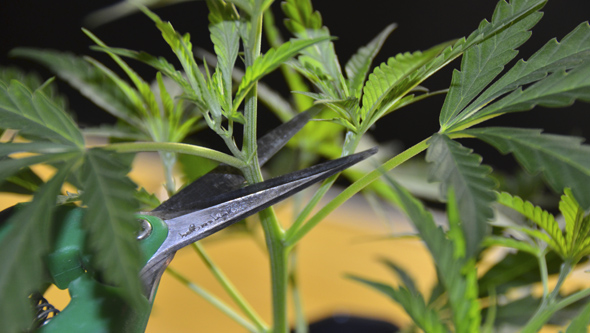
Stakes are used to hold your plants up in case of extreme wind, breakage or as an extra helping hand to branches with larger buds. They can also be used to direct your plants to grow in a certain way. At La Huerta Grow Shop you can find various types of stakes, as well as nets used to grow in SCRoG style.
Dark Netting
Dark netting is super useful on balconies and terraces near the street where you’re looking to be as discreet as possible. They’re also useful for shading your flowerpots and substrate, which stops them from heating up too much; this can kill of your plants if it’s not addressed.
If the sun is coming down hard on the tiles and is heating up the floor around your plants, this can be devastating for your plants’ roots. In this case, you’ll need to set up a shading net using some pegs.
Tool Maintenance
Tool maintenance when growing cannabis is essential if you want to keep them around for your next grow. You’ll need to make sure to keep them clean and disinfect and sterilize all of the tools you use after each grow. This keeps everything clean and can stop insects and pathogens from getting close to your plants. It also allows you to save money so you can buy insecticides, fertilizers, flowering products etc.
Check out our blog if you need more information regarding how to grow feminized and regular cannabis plants outdoors.
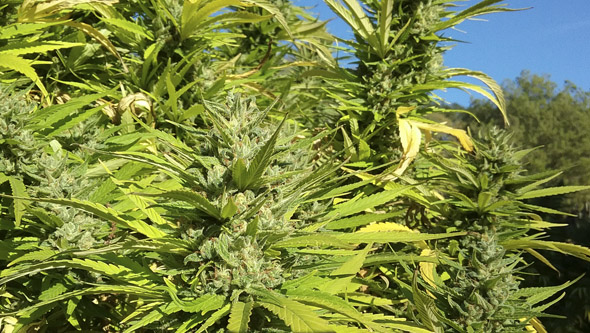
At La Huerta Grow Shop you’ll have access to all of the tools needed to set up your outdoor cannabis grow, as well as the best seeds, fertilizers, stimulants etc. We have a professional team that can help you out at any time!
